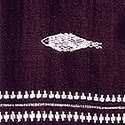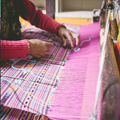Tribal Weaving of Odisha,
The tribal saris, scarves, and woven fabric lengths of the Koraput-Bastar region are woven in a heavy count cotton ranging from 10 to 20. The weaver uses a three-shuttle interlock patterning which makes available innumerable combinations in scale and volume. The characteristic natural dye colouring used is derived from the deep red aal or madder dye which is extracted from the root of the Indian Madder tree. The powerful and vibrant deep maroon that is obtained is often darkened to brown with the addition of harikari or sulphate of iron. These colours combined with the natural unbleached off-white colour of the yarn produce dramatic results. The immense contemporary appeal of the saris and fabrics of this region is enhanced rather than reduced by the limited colour palate and the austerity of the design available. The designs used have an underlying symbolism and are largely inspired by nature or by significant objects of daily use. The dyeing can be done only in the summer months as the monsoon brings the process to a halt, while the yarn does not dry fast enough in the winter months. The dyeing process is long and tedious and the quality of the aal dyed yarn is a determining factor in the end price. The design and craftsmanship displayed on the borders and pallus of the sari also affect the price.
The tribal saris, scarves, and woven fabric lengths of the Koraput-Bastar region are woven in a heavy count cotton ranging from 10 to 20. The weaver uses a three-shuttle interlock patterning which makes available innumerable combinations in scale and volume. The characteristic natural dye colouring used is derived from the deep red aal or madder dye which is extracted from the root of the Indian Madder tree. The powerful and vibrant deep maroon that is obtained is often darkened to brown with the addition of harikari or sulphate of iron. These colours combined with the natural unbleached off-white colour of the yarn produce dramatic results. The immense contemporary appeal of the saris and fabrics of this region is enhanced rather than reduced by the limited colour palate and the austerity of the design available. The designs used have an underlying symbolism and are largely inspired by nature or by significant objects of daily use. The dyeing can be done only in the summer months as the monsoon brings the process to a halt, while the yarn does not dry fast enough in the winter months. The dyeing process is long and tedious and the quality of the aal dyed yarn is a determining factor in the end price. The design and craftsmanship displayed on the borders and pallus of the sari also affect the price.
Tribhuvanam Silk Sari Weaving of Tamil Nadu,
Thirubuvanam town in Tamil Nadu has been a traditional place of silk rearing and weaving and this custom continues till today. Woven using silk warp and weft the Thirubuvanam silk sarees are known for their lustrous patina and high quality. The intricately designed borders and pallu/end piece usually have motifs inspired by nature, flora and fauna and the surrounding architectural features on them. These motifs include naturalistic depictions of flowers, leaves and fruits; temples and temple spires; mayilkan or renderings of a peacock’s eye to rudraksham or the beads of a Rudraksha tree to other traditional motif designs. The borders are wide and often embellished with zari/metallic threads for an additional shimmer. Apart from saris the weavers of Thirubuvanam silk weave pattu langas for women and children. Silk yarn is made available through the government agencies and the weavers of the Thribuvanam silk saris are highly skilled. Saris are woven, with a special box fixed above the loom, in natural floral and animal designs
Thirubuvanam town in Tamil Nadu has been a traditional place of silk rearing and weaving and this custom continues till today. Woven using silk warp and weft the Thirubuvanam silk sarees are known for their lustrous patina and high quality. The intricately designed borders and pallu/end piece usually have motifs inspired by nature, flora and fauna and the surrounding architectural features on them. These motifs include naturalistic depictions of flowers, leaves and fruits; temples and temple spires; mayilkan or renderings of a peacock’s eye to rudraksham or the beads of a Rudraksha tree to other traditional motif designs. The borders are wide and often embellished with zari/metallic threads for an additional shimmer. Apart from saris the weavers of Thirubuvanam silk weave pattu langas for women and children. Silk yarn is made available through the government agencies and the weavers of the Thribuvanam silk saris are highly skilled. Saris are woven, with a special box fixed above the loom, in natural floral and animal designs
Tweed of Ranikhet, Uttarakhand,
In an old re-purposed church building with high ceilings and stained glass windows, a community centre, Kumaon Regimental Center's Community Centre, is run by a welfare organization for army widows. One half is a factory where you can see workers at hand-looms producing shawls and tweed, while the other half is a modern shop selling the finished products, along with candles, condiments and shoes. Great quality Australian Merino wool and hours spent on handloom weaving produce one Dharchuli Shawl with ethnic patterns and many other products like Tweed coats etc.
In an old re-purposed church building with high ceilings and stained glass windows, a community centre, Kumaon Regimental Center's Community Centre, is run by a welfare organization for army widows. One half is a factory where you can see workers at hand-looms producing shawls and tweed, while the other half is a modern shop selling the finished products, along with candles, condiments and shoes. Great quality Australian Merino wool and hours spent on handloom weaving produce one Dharchuli Shawl with ethnic patterns and many other products like Tweed coats etc.


